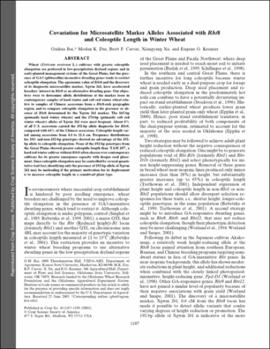| dc.contributor.author | Bai, Guihua | |
| dc.contributor.author | Das, Modan K. | |
| dc.contributor.author | Carver, Brett F. | |
| dc.contributor.author | Xu, Xiangyang | |
| dc.contributor.author | Krenzer, Eugene G. | |
| dc.date.accessioned | 2015-10-16T20:47:52Z | |
| dc.date.available | 2015-10-16T20:47:52Z | |
| dc.date.issued | 2004-07 | |
| dc.identifier | okds_Carver_CS_2004-07_2.pdf | |
| dc.identifier.citation | Bai, G., Das, M. K., Carver, B. F., Xu, X., & Krenzer, E. G. (2004). Covariation for microsatellite marker alleles associated with Rht8 and coleoptile length in winter wheat. Crop Science, 44(4), 1187-1194. https://doi.org/10.2135/cropsci2004.1187 | |
| dc.identifier.uri | https://hdl.handle.net/11244/19803 | |
| dc.description.abstract | Wheat (Triticum aestivum L.) cultivars with greater coleoptile elongation are preferred in low-precipitation dryland regions and in early-planted management systems of the Great Plains, but the presence of GA3 (gibberellin)-insensitive dwarfing genes tends to restrict coleoptile elongation. The agronomic value of Rht8 and the discovery of its diagnostic microsatellite marker, Xgwm 261, have accelerated breeders' interest in Rht8 as an alternative dwarfing gene. Our objectives were to determine allelic distributions at the marker locus in contemporary samples of hard winter and soft red winter wheat relative to samples of Chinese accessions from a Rht8-rich geographic region, and to compare coleoptile elongation in the presence or absence of Rht8 determined by the Xgwm 261 marker. The 165-bp (primarily hard winter wheats) and the 174-bp (primarily soft red winter wheats) alleles of Xgwm 261 were most frequent. About 8% of all U.S. accessions carried the 192-bp allele diagnostic for Rht8, compared with 64% of the Chinese accessions. Coleoptile length varied among accessions from 4.4 to 11.4 cm. Frequency distributions for 192- and non-192-bp genotypes showed no advantage of the 192-bp allele to coleoptile elongation. None of the 192-bp genotypes from the Great Plains showed greater coleoptile length than 'TAM 107', a hard red winter cultivar without Rht8 often chosen over contemporary cultivars for its greater emergence capacity with deeper seed placement. Since coleoptile elongation may be controlled by several quantitative trait loci, identifying only the presence of 192-bp allele of Xgwm 261 may be misleading if the primary motivation for its deployment is to increase coleoptile length in a semidwarf plant type. | |
| dc.format | application/pdf | |
| dc.language | en_US | |
| dc.publisher | Crop Science Society of America | |
| dc.rights | This material has been previously published. In the Oklahoma State University Library's institutional repository this version is made available through the open access principles and the terms of agreement/consent between the author(s) and the publisher. The permission policy on the use, reproduction or distribution of the material falls under fair use for educational, scholarship, and research purposes. Contact Digital Resources and Discovery Services at lib-dls@okstate.edu or 405-744-9161 for further information. | |
| dc.title | Covariation for microsatellite marker alleles associated with Rht8 and coleoptile length in winter wheat | |
| osu.filename | okds_Carver_CS_2004-07_2.pdf | |
| dc.description.peerreview | Peer reviewed | |
| dc.identifier.doi | 10.2135/cropsci2004.1187 | |
| dc.description.department | Plant and Soil Sciences | |
| dc.type.genre | Article | |
| dc.type.material | Text | |
| dc.subject.keywords | triticum aestivum | |
| dc.subject.keywords | durum wheat | |
| dc.subject.keywords | winter wheat | |
| dc.subject.keywords | landraces | |
| dc.subject.keywords | cultivars | |
| dc.subject.keywords | genotype | |
| dc.subject.keywords | provenance | |
| dc.subject.keywords | microsatellite repeats | |
| dc.subject.keywords | dwarfing | |
| dc.subject.keywords | genes | |
| dc.subject.keywords | alleles | |
| dc.subject.keywords | quantitative trait loci | |
| dc.subject.keywords | genetic markers | |
| dc.subject.keywords | coleoptiles | |
| dc.subject.keywords | plant growth | |
| dc.subject.keywords | genetic variation | |
| dc.subject.keywords | great plains region | |
